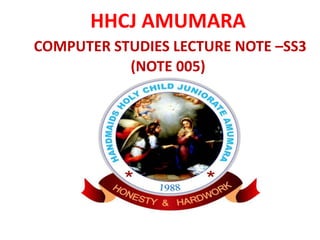
Data Conversion and Computer Components
- 1. HHCJ AMUMARA COMPUTER STUDIES LECTURE NOTE –SS3 (NOTE 005)
- 2. COMPUTER DATA CONVERSION Data conversion is the conversion of computer data from one format to another DEFINITION OF REGISTERS, ADDRESS AND BUS: REGISTERS : Registers are temporary storage areas for instruction or data. It can also be defined as a special, high-speed storage area within the CPU. They are not part of the memory; rather they are special additional storage locations that offer the advantage of speed. Register works under the direction of the control unit to accept, hold and transfer instruction or data and perform arithmetic or logical comparison at high speed. Register are the fastest memory available for use in the PC, because they are hard- wired right into the processor logic.
- 3. • Address: A memory address is an identifier for a memory location, at which a computer program or a hardware device can store data and later receive it. • Bus: A bus, in computing, is a set of physical connections (cables, printed circuits, etc.) which can be shared by multiple hardware components in order to communicate with one another. • The purpose of buses is to reduce the number of "pathways" needed for communication between the components, by carrying out all communications over a single data channel.
- 4. TYPES OF BUS • There are generally two buses within a computer: • 1. Internal Bus: The internal bus (sometimes called the front-side bus, or FSB for short). The internal bus allows the processor to communicate with the system's central memory (the RAM). • 2. Expansion Bus: The expansion bus (sometimes called the input/output bus) allows various motherboard components (USB, serial, and parallel ports, cards inserted in PCI connectors, hard drives, CD- ROM and CD-RW drives, etc.) to communicate with one another. However, it is mainly used to add new devices using what are called expansion slots connected to the input/output bus.
- 5. TYPES OF REGISTER AND FUNCTIONS • There are many types of registers; some of these are given below: • 1. Memory Data Register (MDR): This register contains the data to be stored in the computer storage or the data after a fetch from the computer storage. • 2. Current Instruction Register (CIR): CIR stores the instruction currently being executed or decoded. • 3. Memory Address Register (MAR): MAR holds the memory address of data and instruction. • 4. Program Counter (PC): PC commonly called instruction pointer (IP) and sometimes called instruction address register. It is a register that holds the address of the memory location of the next instruction when the current instruction is executed by the microprocessor. • 5. Accumulator Register: This register is used for storing the results that is produced by the system.
- 6. DIFFERENCES BETWEEN REGISTERS AND MAIN MEMORY
- 7. FUNCTIONS OF A REGISTER 1. Holds the address of memory where CPU wants to read or write data 2.Holds the contents of data instruction read from or written in memory 3.Used to specify the address of a particular I/O device 4.Used for exchanging data between the I/O module and the processor 5.Used to store the address of the next instruction to fetch for execution 6.It stores current instruction being executed or coded 7.It allows the bits of its content to be moved to left or right (shift register) 8.It holds the memory addresses of data and instruction during execution phase 9.It is used to store the result produced by the system
- 8. STEPS INVOLVED IN HOW A COMPUTER CONVERTS DATA TO REQUIRED INFORMATION Fetch-Execute Cycle • The steps in the processing cycle are as follows: • a. Fetch the next instruction: The program counter contains the address of the next instruction to be executed; the control unit goes to the address in the memory specified in the program counter, make a copy of the contents and places the copy in the instruction register. • Decode the Instruction: In order to execute the instruction in the instruction register, the control unit has to determine what the instruction is. • Get Data If Needed: It may be that the instruction to be executed requires additional memory accesses in order to complete its task. If this is the case, the control unit must get the content of the memory location. Execute the Instruction: Once an instruction has been decoded and any data fetched, the control unit is ready to execute the instruction. Execution involves sending signals to the arithmetic/logic unit to carry out the processing. When the execution is complete, the cycle begins again.
- 9. FACTORS AFFECTING THE SPEED OF DATA TRANSFER The amount of RAM memory. The speed and generation of your CPU (the system clock) The size of the Register on your CPU. The Bus width. The Bus speed. The amount of Cache memory.
- 10. STAY AT HOME, STAY SAFE , BE POSITIVE. (JULY 12,2020)